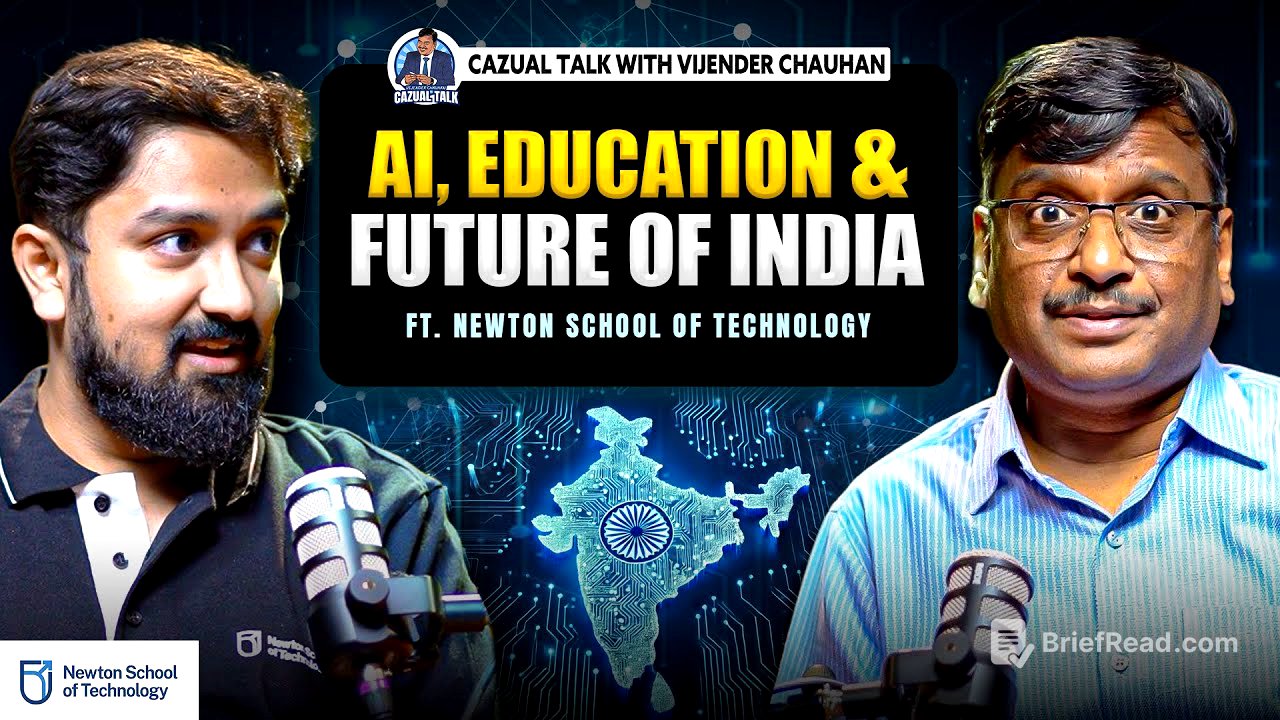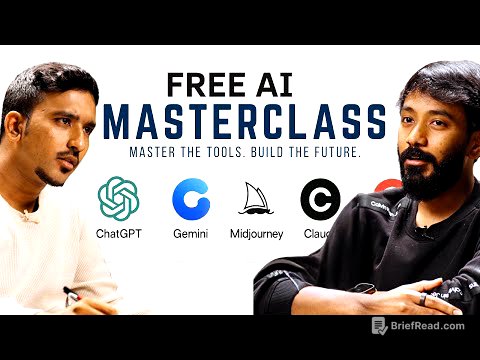TLDR;
This video features a conversation with Siddharth Maheshwari from Newton School of Technology (NSUT), discussing the evolving landscape of education and technology in India. Key points include the importance of youth in driving change, the role of AI in coding and education, and the need for a balance between public and private investment in education. The discussion also touches on addressing biases in AI, the significance of practical skills, and NSUT's vision for creating a copyable and sustainable education model.
- Youth are essential for driving change and innovation in education.
- AI presents both challenges and opportunities for coding jobs and bridging the digital gap.
- A combination of public and private investment is necessary to improve education and develop human capital in India.
Preview [0:00]
The preview highlights the discussion's key themes, including the impact of good faculty, the entrepreneurial spirit needed in the tech industry, and the challenges posed by AI in job markets. It also touches on India's position in the global AI race and the importance of national security in technological advancements.
Welcoming Siddharth Maheshwari [1:10]
The host introduces Siddharth Maheshwari as a new-generation educationist who is transforming universities and the educational landscape. He contrasts Siddharth's youth with the traditional image of educationists, emphasizing the changing dynamics in the field of education.
Why Youth Drive Change [2:18]
Siddharth explains why he believes young people are the primary drivers of change, citing examples like NASA's Apollo mission and Tesla's Mars project, where the average age of scientists and engineers is relatively young. He argues that youth possess a revolutionary spirit unburdened by cynicism, making them ideal agents of change, especially in education.
Siddharth’s Background and Inspiration [3:35]
Siddharth shares his background, growing up in a small town in Uttar Pradesh without a railway station. His early exposure to computers and the internet opened up a new world for him, leading to coding and website development. By the time he was in 10th grade, he was earning more than his father, solidifying his career path in computer science. He prepared for and joined IIT, which he acknowledges as a life-changing experience.
Challenges at IIT and Faculty Impact [5:33]
Despite his excitement about joining IIT, Siddharth found the faculty less engaging initially, with many teachers delivering classes without passion. However, he met a young electronics faculty member from IIT Bombay who taught with immense passion, changing his perspective. This experience highlighted the critical role of inspiring educators in shaping students' lives.
IIT’s Competitive Environment [7:07]
Siddharth acknowledges the highly competitive environment at IIT, where many students are exceptionally intelligent and perform well academically. He notes that IIT opened up a whole new world for him, despite the challenges.
NSUT’s Mission vs. IIT [8:15]
Siddharth clarifies that NSUT is not competing with IIT but aims to establish a parallel institution focused on undergraduate tech education. While IIT excels in research, NSUT focuses on fostering entrepreneurship and practical skills, encouraging students to create startups and innovate in their careers, whether at companies like Google or Microsoft. NSUT's faculty comes from industry backgrounds, bringing real-world experience to the classroom.
Will AI Steal Coding Jobs? [9:10]
The discussion addresses the concern that AI will displace coding jobs. Siddharth argues that while AI may disrupt the job market, technology has always been a disruptor. He draws parallels to the introduction of computers, which initially sparked fears of job losses but ultimately led to economic growth and new opportunities. Low-level coding jobs may be at risk, but the need for problem solvers will increase. Coding is becoming simpler, potentially leading to more people engaging in it, and those who are skilled at computer science will be able to direct AI.
Can AI Bridge the Digital Gap? [12:17]
Siddharth counters the idea that AI will worsen the digital divide, arguing that technology tends to reduce distances and create a level playing field. He uses the example of ChatGPT, which is accessible to anyone, regardless of their location or socioeconomic status. Technology can make entrepreneurship easier and more accessible to everyone.
NSUT’s AI Policy for Students [14:11]
Siddharth explains NSUT's policy on AI usage for students, which varies by subject. Initially, students are encouraged to learn fundamentals without AI assistance, similar to learning math without a calculator. Once they have a solid foundation, they are encouraged to use AI to enhance their work and explore more abstract problems.
Natural Language Coding with AI [15:03]
The conversation touches on the possibility of coding in natural language, a long-imagined concept. Siddharth believes that AI is gradually reducing the gap between coding and natural language, envisioning a future where AI can execute tasks based on simple commands.
India’s Position in Global AI Race [16:03]
The discussion shifts to India's position in the global AI race, particularly compared to China and the US. Siddharth admits that India is currently behind in developing its own AI models and compute power. He emphasizes the need for a national mission to develop AI talent and infrastructure, similar to the efforts made in nuclear power. He also highlights the importance of AI in national security.
AI and National Security [18:43]
Siddharth emphasizes the importance of AI in national security, drawing parallels to nuclear power. He notes that countries with advanced computing power can carry out precise operations, underscoring the need for India to invest in AI for its own security.
Public vs. Private Investment in Education [20:21]
The conversation explores the roles of public and private investment in education. Siddharth believes that both are necessary, with the government providing overall support and the private sector driving innovation. He praises the changes UGC has brought in over the last four-five years to bridge the gap between the industry and the academy.
University Rankings and Human Capital [21:56]
Siddharth downplays the importance of university rankings, arguing that the focus should be on building human capital. He emphasizes the need to create a large pool of technically and ethically sound individuals who can drive the country forward.
Inclusion in Education [23:20]
The discussion addresses inclusion in education, focusing on providing opportunities for students from diverse backgrounds. Siddharth suggests that while creating AI requires a focused, nimble approach with the best talent, democratizing access to education through technology is crucial for overall capability building.
Internet Access and Social Mobility [25:43]
Siddharth shares his personal experience, noting that access to the internet was crucial for his own social mobility. He emphasizes the role of technology in providing opportunities for individuals from small towns and disadvantaged backgrounds.
Addressing Biases in LLMs [27:35]
The conversation addresses the potential for biases in Large Language Models (LLMs). Siddharth acknowledges that biases can be introduced if the data used to train the models is not diverse. He emphasizes the importance of using data from all sections of society and different languages to mitigate these biases.
Balancing Passion & Boring Tasks [28:23]
Siddharth discusses the challenge of balancing passion with mundane tasks, a common issue among young people. He emphasizes that all work, whether at home or in a startup, involves routine and less exciting tasks. He encourages the youth to embrace all kinds of work and understand that passion is often overrated.
Impact Stories from NSUT [30:31]
Siddharth shares several impact stories from NSUT, including a girl from a tier-three college who secured a high-paying job at Rubrik and a physically disabled student who found a remote job through Newton. He also mentions a single mother who secured a job at a large GCC, highlighting the transformative impact of education.
When Students Lose Motivation [35:11]
Siddharth expresses disappointment when students lose motivation, particularly due to personal issues. He notes the challenges of helping students get back on track and questions his own effectiveness as a teacher in such cases.
NSUT’s Use of Technology [36:11]
Siddharth details how NSUT uses technology, emphasizing its three pillars: industry-relevant curriculum, faculty from the industry, and technology integration. He mentions projects like UAVs for delivering food in emergencies and underwater drones. NSUT uses a portal for classes, recordings, and mentor connections, and AI-driven mock interviews to boost student confidence.
NSUT’s Vision and Early Challenges [38:53]
Siddharth recounts the early challenges of starting NSUT with limited funds. He and his co-founder, Nishant, were driven by the vision of solving a significant problem and making a direct impact on the country. Their investors backed them, and they focused on providing quality education to students from tier-two and tier-three colleges.
Future Vision for NSUT [41:27]
Siddharth's vision for NSUT is to create a copyable and sustainable education model that others can replicate. He aims to produce graduates who are not only skilled in technology but also ambitious, problem solvers, and star employees.
Closing Remarks and Gratitude [42:51]
The host concludes the conversation, expressing gratitude to Siddharth for sharing his journey and insights. He notes that the discussion was informative and inspiring, highlighting the importance of the work being done at NSUT.









